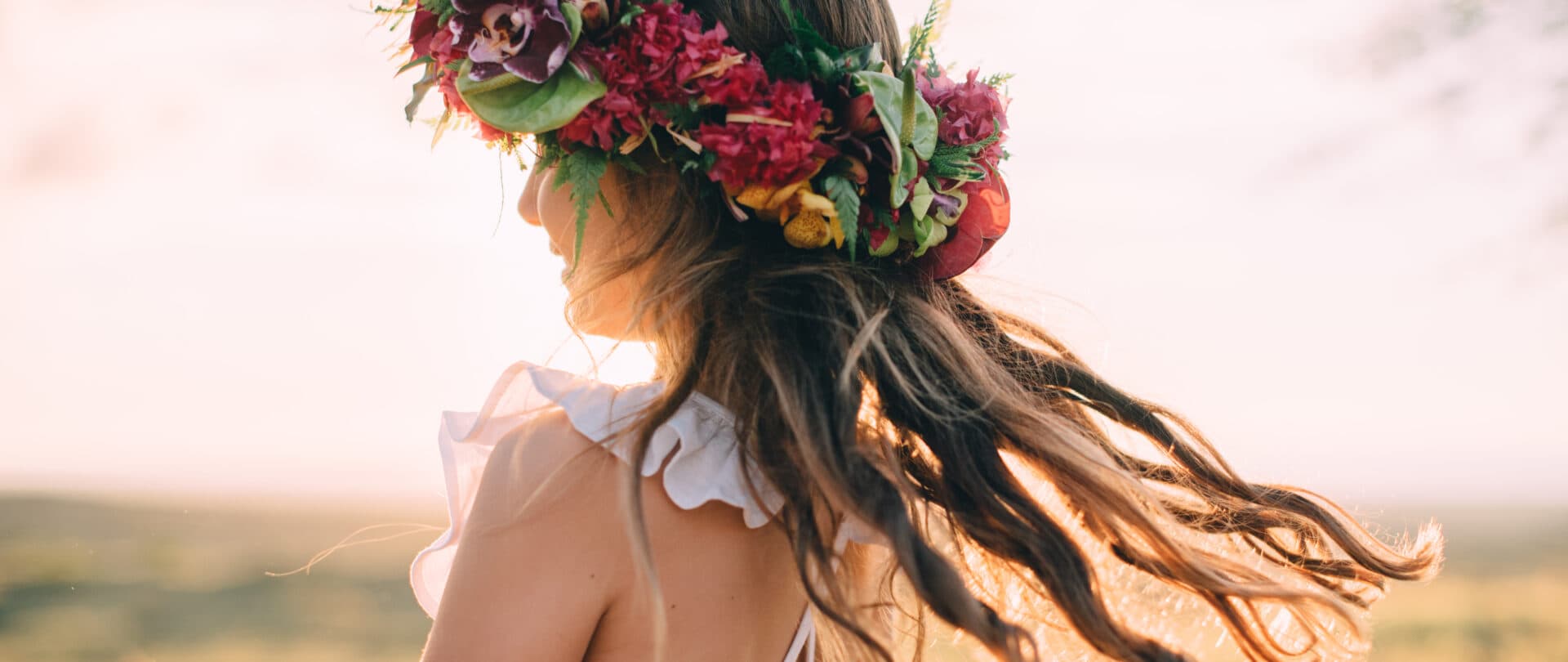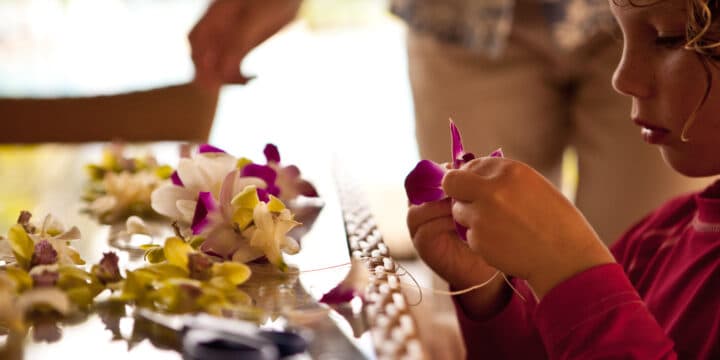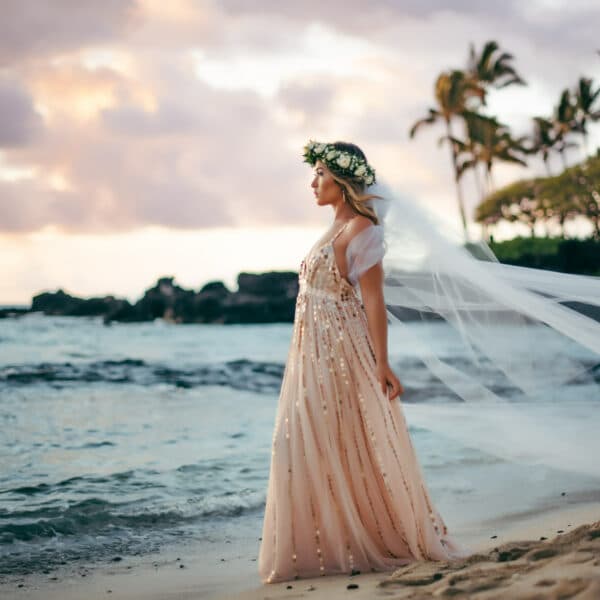
In the State of Lei
In Hawai‘i, and the ancient art of lei making is a treasured tradition that continues to endure
BY Rina Mae Jabolina
I watched Aunty’s fingers move gracefully, yet swiftly, as she spun the softened ti leaves, braiding each strand while intertwining silky red torch ginger petals. Her hand movements resembled a perfectly choreographed dance. She didn’t speak or instruct me in any of the steps. As the sweet floral fragrance delighted my senses, I watched quietly and in admiration of the intricate arrangement lengthening. Aunty Jocelyn is a lei (floral garland) artist, and she is teaching me the cherished art of lei making.
This beloved art was introduced to Hawai‘i by Polynesian voyagers. Ancient Hawaiians wore lei for adornment and to distinguish rank, royalty, and wealth. Flowers, leaves, shells, seeds, nuts, feathers, and even bones and teeth of various animals were used as craft materials. As a tangible representation of Hawai‘i’s aloha spirit—love, warmth, hospitality, respect, and peace—the lei will always remain a cultural identifier of Hawai‘i, and the art of lei making is a treasured tradition that continues to endure.
The art is taught in Hawaii’s school system, public and private workshops, and often at hotels and resorts that offer lei making as a guest activity. If you have not yet treated yourself to a lei making experience, you should. The pleasant atmosphere and tropical scents relaxes your mood, but awakens your inner creativity. In creating your lei, you’ll have a vast assortment of vibrant flowers and natural foliage to choose from. No official meanings are tied to the different colors of Hawaiian lei, but the materials selected create special meanings and are often chosen for specific occasions. Though there are countless beautiful lei designs, it’s worth familiarizing yourself with some of the most popular lei you’ll find throughout the Hawaiian Islands.
Lei Lā‘ī (Ti Leaf Lei)
Ti plants grow abundantly in Hawai‘i, especially on the Big Island. Since green ti leaves are easily obtainable, it is used in many lei creations. A common ti leaf lei design is a simple braid, which can be accented with tropical flowers. Believed by Hawaiians to bring good fortune and ward off evil spirits, lā‘ï lei were at one point reserved only for Hawaiian royalty. Over time, however, the lā‘ï evolved into a lei appropriate for all to wear and for any given occasion.
Lei Maile (Hawaiian Vine Lei)
The maile lei is said to be the noblest of lei. Maile is a native shrub that boasts an unforgettable woodsy vanilla scent. Thick leafy strands are knotted and then twisted together to form an open-ended garland. Maile lei are also believed to protect the wearer and bestow luck. In ancient Hawai‘i, this lei of royalty was exchanged by chiefs as a symbol of peace. The maile lei continues to symbolize peace, respect, friendship, and love. Though maile lei can be worn by anyone, they are often reserved for males during special occasions and ceremonies. Grooms will often sport this elegant garland below the belt line, often down to the knees.
Lei Kukui (Candlenut Lei)
The kukui tree, or candlenut tree, is the state tree of Hawaii, and grows everlasting sleek dark nuts that are painstakingly sanded down, polished, punctured, and strung to form a kukui nut lei. In the past, kukui nut lei were only worn by royalty. Like lā‘ï and maile lei, kukui nut lei can be worn by anyone today. Because of its popularity, kukui nut lei are commercially produced in many colors and imported into the state of Hawai‘i. Regardless of origin, however, the kukui nut lei is usually given in the islands as a sign of respect and appreciation.

Lei ‘Okika (Orchid Lei)
These delicate, long-lasting lei, often found in hues of purple, white, and green, are usually crafted using Dendrobium orchids, which grow favorably on the Big Island, also nicknamed the Orchid Isle. There is an amazing array of methods of stringing orchids that new designs appear in competitions and lei shops every year. Available year round, ‘okika lei are usually given as an expression of thanks or welcome to visitors.
Lei Pīkake (Peacock or Jasmine Lei)
Pīkake (meaning peacock) lei are made from Arabian jasmine and not peacock feathers as one would think. This lei dedicated to women received its name by Hawai'i’s beloved Princess Ka‘iulani who named it after her favorite bird. In creating a pïkake lei, the buds, rather than fully bloomed flowers, are strung together, and several lei strands are combined to create a “rope lei.” The sweet-smelling pïkake lei has taken on a romantic meaning in the Hawaiian Islands. According to custom, one lei strand or two could symbolize friendship; three or four—a romance; five or six—“I love you;” more—you are the bride.
Lei Po‘o (Head Lei)
Lei po‘o, a lei worn on the po‘o (head), has recently increased in popularity, which may be attributed to Bohemian trends and social media flower crown filters. You’ll often see male and female hula dancers wearing this style of lei. A masculine lei poÿo is generally made only with greenery, while a lei po‘o worn by a woman often incorporates beautiful flowers. Lei po'o is often worn by brides on their wedding day and on other special occasions. A lei po'o should never be mistaken simply as a flower crown or accessory, however. Like all other lei, each lei po'o is created and worn with intent and meaning.

